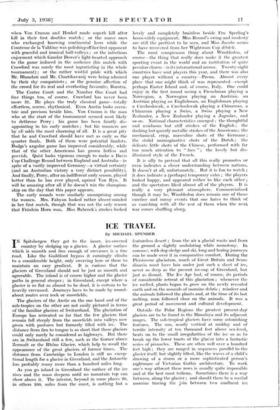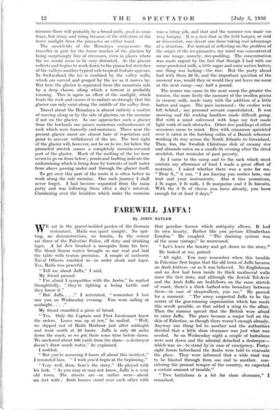ICE TRAVEL
By MICHAEL SPENDER
The glaciers of the Arctic on the one hand and of the sub-tropics on the other are not easily pictured in terms of the familiar glaciers of Switzerland. The glaciation of- Europe has retreated so far that the few glaciers that remain fall steeply from the snowfields into valleys now green with pastures but formerly filled with ice. The distance from firn to tongue is so short that these glaciers could only rarely be considered as highways. But there are. in Switzerland still a few, such as the Gorner above Zermatt or the Rhine Glacier, which help to recall the appearance of great glaciers of former times. The distanee from Cambridge to London is still no excep- tional length for a glacier in Greenland, and 'the Antarctic has probably many more than a hundred miles long. • As you go inland in Greenland the surface of the ice rises and the mass deepens until no mountain top can show above it. The interior, beyond in some places 20, in -otherS 100, miles from the coast, is nothing but a featureless desert ; from the air a glacial waste and from the ground a slightly undulating white monotony. In summer, with dog-sledge and ski, long and boring journeys can be made over it in comparative comfort. During the Pleistocene glaciation, much of Great Britain and Scan dinavia must have lain under just such a sheet of ice, never so deep as the present ice-cap of Greenland, but just as dismal. The Ice Age had, of course, its periods of considerable retreat of this glaciation ; -whenever the ice melted, plants began to grow on the newly revealed earth and on the mounds of moraine debris ; reindeer and the animals followed the plants and, at the time of its last melting, man followed close on the animals. It was a great period of movement and cultural development.
Outside the Polar Regions the greatest present-day glaciers are to be found in the Himalaya and its adjacent ranges. The sub-tropical glaciers have some astonishing features. The sun, nearly vertical at midday and of terrific intensity at ten thousand feet above sea-level, beats on to the small irregularities of the ice so as to break up the lower tracts of the glacier into a fantastic series of pinnacles. These are often well over a hundred feet high ; they are ranged in sequences parallel to the glacier itself, but slightly tilted, like the waves of a child's drawing of a storm or a more sophisticated person's nightmare of Victorian Gothic architecture. To work one's way athwart these rows is usually quite impossible and at the best most tedious. Sometimes there is a way between, along the glacier ; and should there be a medial moraine tracing the join between two confluent ice streams there will probably be a broad path, good in some ways, but stony and tiring because of the reflection of the fierce sunlight from the pinnacles on either hand.
The snowfields of the Himalaya compensate the traveller in part for the lower reaches of the glaciers by being surprisingly free of crevasses, even in places where the ice would seem to be very distorted. As the glacier collects and begins to work down to the pinnacled stretches of the valleys another typical sub-tropical feature appears. In Switzerland the ice is confined by the valley walls, which are carved and gouged by the ice as it moves by. But here the glacier is separated from the mountain side by a deep chasm, along which a torrent is probably running. This is again an effect of the sunlight, which heats the rock and causes it to radiate so strongly that the glacier can only exist along the middle of the valley floor.
Travel about the Himalaya is almost entirely a matter of moving along or by the side of glaciers, on the moraine if not on the glacier. As one approaches such a glacier from the lowlands one passes numerous embankments of rock which were formerly end-moraines. Those near the present glacier snout are almost bare of vegetation and point to arecent withdrawal of the ice. The first sight of the glacier will, however, not be on to ice, for below the pinnacled stretch comes a completely moraine-covered part of the glacier. Much of the melting of the ice here seems to go on from below; ponds and faulting indicate the undermining which is being done by torrents of melt water from above passing under and through the glacier itself.
To get over this part of the route it is often better to work along the side moraine. One such journey I shall never forget. I had become separated from the main party and was following them after a day's interval. Clambering over the boulders which make the moraine was a tiring job, and that and the summer sun made me very hungry. It is a fact that in the field hunger, or cold or discomfort, can divert one from taking real advantage of a situation. For instead of reflecting on the problem of the origin of the ice-pinnacles, my mind was concentrated on one image, namely, rice-pudding. The concentration was made urgent by the fact that though I had with me some powdered milk, a little sugar and some native butter, one thing was lacking—the rice. But the party ahead had with them 20 lb, and the important question of the moment was, would they or would they not leave me some at the next camp—say, half a pound.
The nearer one came to the next camp the greater the tension, the more lively the memory of the swollen grains in creamy milk, made tasty with the addition of a little butter and sugar. The pace increased ; the coolies were left behind ; my personal servant expostulated. It was snowing and the rocking boulders made difficult going. But with a mind enlivened with hope my feet made light work of such obstacles. Other rice puddings of other occasions came to mind. Rice with cinnamon sprinkled over it eaten in the lurching cabin of a Danish schooner working its way across the North Atlantic to Greenland. Then, too, the Swedish Christmas dish of creamy rice and almonds eaten on a candle-lit evening after the dried stockfish, that reminder of past poverty.
As I came to the camp and to the sack which must contain my allowance of food I made a great effort of restraint. I asked whether there was a note for me. " Dear S.," it ran, " I am leaving you coolies here, one tent and your instruments. Also 6 tins pemmican, 5 lb sugar, 2 lb milk, 1 lb margarine and 2 lb biscuits. With the 2 lb of cheese you have already, you have enough for at least 9 days."















































 Previous page
Previous page